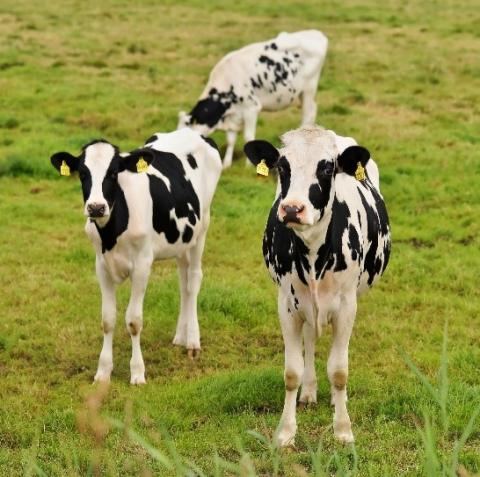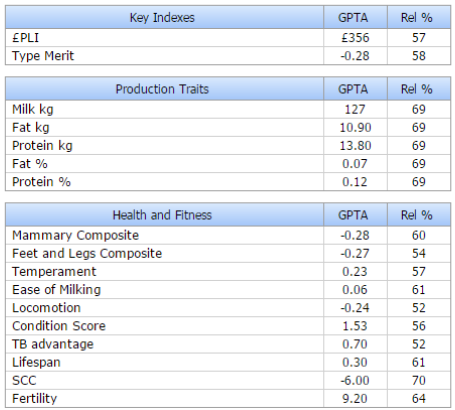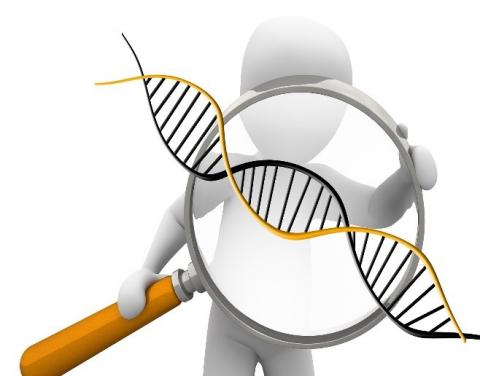Take home messages:
- The cost for genotyping has now significantly reduced; therefore more animals are being routinely genotyped.
- Genomic selection not only allows for the better selection of animals for the herd but also better accuracy in breeding pair selection
- Currently work is being conducted involving the genomic testing of heifers at Marian Mawr demonstration farm as part of the Farming Connect demonstration site network.
Genomics is a technology that can use DNA information on a large scale to predict the performance
potential of cattle. Genomic selection also enables farmers to select animals for the next generation of replacements within the herd rather than relying on phenotypic (observable features of the animal) assessment alone. This allows for the earlier identification of the elite animals within the herd and those which are the poorest breeding animals. The use of genomic technology is becoming more widespread, enabling farmers to breed cattle according to breeding goals; for instance, breeding for higher milk yield in heifers or better fertility in young bulls. Appropriate use of genomics within herd management ultimately can lead to an increase in productivity, health and welfare, shortening the generation interval and increasing genetic improvement.
Employing genetic selection
The genetic improvement of animals within herds occurs when the offspring produced from selected breeding pairs possess the desired traits that achieve the breeding target for a particular farm. This is the result of selection intensity and the accuracy of identifying superior parents e.g. the best breeding pairs to produce the best offspring with the targeted genetic traits required. The Profitable Lifetime Index (£PLI) provides an economic breeding index for UK herds. Over the last 10 years’, genetic evaluations have been developed within the UK, with the goal of genetic testing aimed at the improvement of productivity and longevity in cows by increasing the range and reliability of selection for fitness traits. Recently it has been more common practice to improve genetic gains (increase in animal performance through genetic improvement programmes) within herds by the genomic selection of young bulls, which enables the tracking and identification of individual animals. Since the cost for genotyping has now significantly reduced, more animals are being routinely genotyped. It has been shown that the genotyping of a larger number of bulls from bigger populations has increased the reliability of genomic predictions compared to those from a smaller cohort. However, genetic trends can be increased and inbreeding reduced, by identifying males belonging to new blood lines. Genomic evaluation of herds has shown a significant advantage in increasing overall genetic gains and a study conducted in 2017 has demonstrated a beneficial relationship between annual genetic gain and the number of calves genotyped. By genomic testing at a young age combined with improved management suggests that there is increasing genetic improvement among sires, with this trend also resulting in enhanced genetic improvement in heifers and cows. The combination of information from animal pedigree and genetic markers leads to an increase in the reliability of genomic estimated breeding values (GEBV). Thus, it has been found that young bulls become more competitive relative to progeny tested bulls in herds with extensive genetic gain.
Genetic selection of dairy heifers
More recently, the genetic selection of dairy heifers has been considered a better option than selection for young bulls alone and can play an important part in selecting for breeding by determining which bull to mate with which heifers. Previously, when no pedigree was available for a young heifer, it was considered economically profitable for farms to genotype all young heifers as the cost of genotyping the animals would be covered by animal genetic gains. The prevention of inbreeding between animals is also an important concern; however, it is not economically viable to genotype all heifers just to control inbreeding only. In order to incorporate this technology into the breeding system, thought needs to be applied to breeding strategy to get the best value from genomic testing and reap the rewards. Today with the improved reliability of genetic information, the genomic testing of dairy heifers has become important in breeding and replacement strategies. By testing young heifers rather than the older animals, those with poorer genetic gains can be removed from breeding regimes and selection intensity can be increased, resulting in faster genetic gain, superior heifers and a more effective herd.
Genomic profile of one heifer ready for bulling at one of the Farming Connect Demonstration Farms.
Considering the cost of approximately £1500 to rear heifers, significant savings can be achieved by selling or culling the poorest animals. At a cost of around £30 per test dependent on service provider, genotypes can be interpreted and genomic evaluations conducted by providers such as AHDB Dairy and Holstein UK, which will also screen for genetic abnormalities as well as give validation of parentage. Currently work is being conducted involving the genomic testing of heifers at Marian Mawr demonstration farm as part of the Farming Connect demonstration site network. The genomic testing of 2016 heifer calves has been conducted with the first heifer genomic results available in the autumn, for further information please contact Rhys Davies, Dairy Technical Officer and see the Farming Connect website.
The way forward
The additional cost of genomic evaluation is a reasonable expense compared to other available technologies such as embryo transfer, multiple ovulation, or sexed semen, but by applying both methods it is possible to improve both profit and genetic gains. However, before genomic testing is applied on farm it
is important to ascertain which traits will be selected for to achieve on farm goals. For example, selecting traits for ease of milking, condition, fertility, £PLI and lifespan. It is recommended to select genetically superior heifers from a young age from the top 30% of the herd prior to the availability of performance records to select the elite heifers to work with and also to select the bottom 50% heifers to either cull or mate with beef bulls. This will provide the most cost effective option in most cases. However, genotyping all of the young stock can be cost effective if the parentage is unknown and all of the data from testing will be used to achieve recognised on farm breeding goals. It is advisable for farmers to determine what they require from the herd in the future and identify the strengths and weaknesses in order to make the most gains. The inclusion of testing heifers as well as genomically selected bulls enables farmers to increase the knowledge of the herd and considerably increase the selection intensity. Overall genomic selection not only allows for the better selection of animals for the herd but also better accuracy in breeding pair selection.


